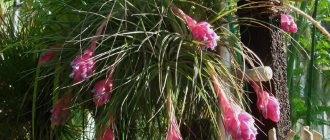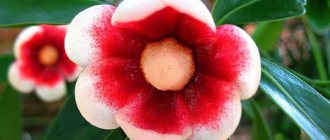Description of the plant
The forest cactus ripsalidopsis or hatiora has abundantly branching segmented shoots of herbaceous type growing upward. Old stems are darker, have barely noticeable tufts of thin bristles at the edges, while young shoots are lighter and almost flat, sometimes reaching a length of up to 2 meters. Small buds appear at the ends of the branches in spring and bloom during the day.
White, scarlet, lilac, crimson, orange, pink flowers have yellow stamens and pointed long petals. They can reach 7-8 cm in diameter. In the evening they close into buds again, and after 5-7 days of flowering, small round red fruits with black seeds inside are formed in their place. If a ripsalidopsis flower stands in the open sun for a long time, its branches turn a little red.
General description of the species
Ripsalidopsis belongs to a genus of plants that are part of the Cactus family. It is native to humid subtropical Brazilian forests. In this climate there are no sudden changes in temperature; warm showers occur frequently. Cacti growing in conditions of eternal heat and humidity lost their spines and thick skin and grew long stems resembling leaves.
Under natural conditions, ripsalidopsis often grows not on soil, but on trees, which provide support for cacti. At the junction of the stem segments, aerial roots are formed, which help to absorb moisture from the air. When a support is found, they begin to quickly develop and attach to it.
The cactus stores nutrients and moisture in its thick stems, divided into segments. As they grow, the stems begin to hang down, so the Christmas cactus can be grown in an ampelous manner. The length of the stems can reach sixty centimeters.
In spring, flowers appear at the ends of the stems. The total flowering lasts about two months, each flower lives no more than three days. Two or three buds can form on one shoot. The flower petals are semi-double, narrow, and have sharp tips. The color range is small (scarlet, white, burgundy, crimson shades), but very rich and bright. After flowering, fruits are set in place of the buds - light red soft berries.
According to modern botany, Rhipsalidopsis no longer exists as a separate genus. All plants previously classified as a species are now considered a subspecies of the genus of epiphytic cacti Hatiora. In nature, there are about fifteen varieties of forest cactus. Mostly hybrids bred by breeders are grown at home. Of the wild representatives, only two have been domesticated: Ripsalidopsis Gartner and Ripsalidopsis Pink.
Types and varieties
The tropical epiphyte has 2 main types - ripsalidopsis rosea and Gartner. The last shrub has a dense crown. It reaches a height of up to 30 cm and blooms with bright scarlet inflorescences. Pink is widespread in home floriculture, namely its decorative varieties:
- Sirius.
- Torano.
- Tsetuse.
- Anika.
- Phonics.
- Aurepa.
- Andromeda.
Andromeda
Andromeda
Ripsalidopsis gartner
Ripsalidopsis Gartner
In appearance, inexperienced gardeners often confuse this cactus with Zygocactus or Schlumbergera (“Decembrist”), but these crops have fundamental differences. Schlumberger flowers are odorless and have beveled edges, while those of Ripsalidopsis exude a pleasant aroma and have a symmetrical arrangement. They are pleasing to the eye throughout spring and summer, for which the flower is popularly called “Easter cactus”, and a similar plant “Decembrist” begins to bloom only in winter.
Differences between ripsalidopsis and other cacti
In addition to ripsalidopsis, popular:
- Epiphyllum - with beautiful, unusual leaves, fragrant flowers bloom at night.
- Rhipsalis - has long ornate shoots covered with small hairs, they are dotted with flowers during flowering.
- Schlumberger - Decembrist or “Christmas cactus”, blooms at the beginning of winter.
These plants are epiphytes; in their natural environment they attach themselves to tall trees and grow into moss. At the joints of the stems, thin, airy rings are formed that suck moisture from the air.
Schlumberger and Ripsalidopsis are two very similar flowers and are the most common. With a careful comparison, it is easy to distinguish them from each other. The “Decembrist” has jagged, sharp-shaped stems, the flower corollas are beveled, and there is no aroma. The “Easter cactus” has smooth leaf-shaped hanging stems, a symmetrical arrangement of petals, no thick skin or spines, and a pleasant aroma. They also differ in different flowering times.
Humidity and temperature
Hybrid varieties of the ripsalidopsis flower feel comfortable at air temperatures between +18-23 degrees. In the spring, to stimulate flowering, the room temperature is slightly reduced in February-March to +12-15 degrees. During the heating season, make sure that the air is not too dry.
Tropical shrubs love humidity and it is artificially maintained with the help of a humidifier and spraying plain water from a spray bottle onto the foliage. Also, for additional moisture, the flowerpot is placed on a tray with wet moss or river sand, but the water should not stagnate there. At low air temperatures in winter, spraying is stopped.
When and how does it bloom?
Rhipsalidopsis begins flowering in early spring and blooms luxuriantly for two months. The buds appear a month before flowering begins . Flowers bloom at the ends of the shoots. Their colors are abundant and can range from white to red.
When the buds appear, you cannot move or rotate the plant. Otherwise the buds will fall off.
Rhipsalidopsis has a variety of species that can decorate both indoor and outdoor areas. The following varieties are considered the most common:
Epiphytic and bush-like Ripsalidopsis Gartner . This is a creeping plant whose height is 20 centimeters. The shoots are green and flat and reach a length of up to seven cm. From April to May, the cactus pleases with scarlet flowers.
- Small bushy pink . The flowers are pale pink, 5 centimeters in diameter. The flower is not capricious and unpretentious in care.
You can mix several varieties in one pot or in a flowerbed and get an original decoration for your home or plot.
Required lighting
In extreme heat, the pot is placed in the shade and protected from bright direct sunlight, placed on a western or eastern windowsill, where partial shade reigns most of the day. In warm months, you can take the pot out into the garden or onto an open balcony, and rotate it evenly relative to the light source.
During active flowering, it is better not to rearrange all varieties of ripsalidopsis at all, so that they do not drop their buds. Experienced floriculture enthusiasts even make special marks on the windowsill or flowerpot to help monitor the position of the flower.
Aurigo orange
White magic
R. Gartner (Rhipsalidopsis gaertneri)
R. pink (Rhipsalidopsis rosea)
Need for lighting
Ripsalidopsis naturally grows in the shade, so it does not require strong lighting at home. Caring for a flower involves placing a pot with a plant in a shaded area, on a table, shelf or northern windowsill. It is necessary to protect the leaves from sunlight, achieving diffused light in the room.
During flowering, you can move the flower out of the shade a little, but it is not recommended to move or rearrange it with buds - they may fall off. This must be done in advance.
If all the required conditions are met, ripsalidopsis will delight the hostess with abundant, long-lasting flowering, sometimes 2 times a year. Caring for it is not too difficult, so you can easily give such a flower to your friends for a birthday, anniversary or holiday - anyone can grow a beautiful, strong plant from a small store-bought bush.
Soil and watering
To provide quality care for rhipsalidopsis at home, you need to prepare a spacious pot and fertile, well-drained soil for it. You can buy it in a store or prepare it yourself from perlite, river sand, pine bark, humus, manure and peat. The pH level of such a mixture should not be higher or lower than 5-6. In a breathable, nutritious, light substrate, young decorative sapophytes actively grow and develop, suffer less illness and produce young shoots for reproduction. They also love additional additives in the form of peat moss, coniferous or deciduous tree bark.
As for watering, gardeners know that all types of ripsalidopsis love moisture, but severe waterlogging or overdrying is equally dangerous for them. The top layer of soil in a flowerpot is always moistened as it dries, but not more than once every 2-3 days. In autumn, the amount of watering is gradually reduced so that the root system does not rot during the dormant period. In January-February, at the stage of laying buds, they again begin to actively moisten the soil. To do this, use rainwater, bottled or passed through a carbon filter. If there is only tap water, it is purified from excess calcium, fluoride and chlorine by adding a small amount of citric acid or apple cider vinegar. After watering, drain the remaining water from the pan.
Caring for ripsalidopsis at home
Illumination
Needs good lighting, but it should be diffused. It is recommended to place it on windows with east or west orientation. In the warm season, you can take it outside, but you need to provide shading from direct rays of the sun.
Temperature
In summer it needs moderate temperatures (from 18 to 20 degrees). In February–March, the plant needs coolness (about 10–12 degrees) to set flower buds.
Humidity
Requires high air humidity. Therefore, systematic spraying with soft water, which should be at room temperature, is recommended for ripsalidopsis. To increase humidity, you can place moistened moss or expanded clay in the pan, but you must make sure that the bottom of the container does not come into contact with the liquid. During cool wintering, the plant is not sprayed.
How to water
In spring and summer it is necessary to water abundantly. Watering is carried out after the top layer of soil dries. With the onset of autumn, they begin to gradually reduce watering. And in winter, watering should be extremely moderate, especially during cold wintering.
Top dressing
During active growth, fertilizing is done once every 2 weeks. To do this, use mineral fertilizers with a minimum amount of nitrogen, and you can also take fertilizers specifically designed for cacti.
Earth mixture
Suitable soil should be light, slightly acidic (pH 5 or 6), and also well-drained. To prepare the soil mixture, you need to combine turf, deciduous and humus soil, sand and peat, taken in a ratio of 1: 6: 4: 2: 2.
Features of transplantation
Transplantation is carried out after the cactus has faded. Young specimens are replanted once a year, and adults - once every 2 or 3 years.
Reproduction methods
It can be propagated by grafting, stem cuttings, and seeds.
It is very easy to propagate from stem cuttings. To do this, you need to separate 2 or 3 segments from the shoot with a rotational movement and leave it in the open air for 2-3 days to dry. The cutting must be placed in a pot filled with moistened substrate, but it does not need to be buried, but simply leaned against any support. The cuttings will quickly develop roots and can be planted in the soil mixture.
This plant can be grafted onto the stem of Peresia spinosa, and this procedure is recommended in the summer. It is necessary to cut off the branched upper part of the pereskia with all the foliage, so that a bare stem remains. Its upper part must be carefully split. A shoot consisting of 2 or 3 segments is taken as a scion, its end is pointed (in the shape of a wedge). The pointed end of the shoot is inserted into the split. After this, you need to secure the graft and a thorn, long thorn or needle is suitable for this. And then you need to wrap it, using thread or adhesive tape. Place the pot in a place with a temperature of approximately 18–20 degrees. The scion will grow together after half a month and then begin to grow. After this, the bandage is removed, and as soon as branches or leaves appear in the lower part, they are immediately torn off. This plant is distinguished by the fact that it blooms very profusely.
You can grow Ripsalidopsis quite easily from seeds. To obtain them, you will need two adult cacti that are unrelated to each other (you can use different species or varieties). A brush takes pollen from the flowers of one specimen and transfers it to another. When flowering ends, a fruit will appear in the form of a reddish berry. The fruit ripens for a long time and only after it has shriveled can it be picked.
The seeds remain viable for several years. The seeds are sown in a wide pot, into which you need to pour a soil mixture consisting of equal parts of leaf soil and sand. Grown seedlings are transplanted into pots. It is recommended to plant several seedlings in one pot (to obtain a more lush bush).
Pests and diseases
Mealybugs, false scale insects, spider mites and scale insects can settle on the plant.
You can get sick from bacterial or fungal infections.
At first, rot may appear in only one small area of the plant, resulting in a slippery and damp spot. Then the same spots appear on other parts of the cactus.
Antibacterial agents are ineffective in this case. It is recommended to carefully cut off the infected part of the cactus. If rot appears at the base of the stem, then uninfected segments should be separated and then rooted.
In most cases, fungal diseases such as phytium, fusarium or late blight occur.
Fusarium infection can occur through holes left by pests or through wounds. To cure the plant, you will need a fungicide containing active ingredients such as benomyl and chlorothalonil.
A cactus can become ill with late blight or phytium due to an infected substrate, and the root neck is most often affected. It’s quite easy to understand that a plant is sick. It fades, but the soil is moistened. Also, the color of the cactus may fade or become grayish. Treatment with a fungicide designed to combat fungal diseases will be required.
Possible difficulties
- Falling of flowers or segments - stagnation of water in the soil, a lot of fertilizers, cold or dry air, movement of the flower from place to place.
- Slow growth and lack of flowering - little light, improper maintenance during the dormant period, needs feeding.
- The segments become pale, a red tint may appear, as well as brownish spots - too intense lighting, burns from direct rays of the sun.
- The cactus withers, the shoots become drooping, and the base of the stem turns black - stagnation of water in the soil (especially in winter when kept in a cool place).
Advice:
After the buds begin to appear and until the end of flowering, you should not rearrange or rotate the pot. Otherwise, this may cause the buds to fall off. It is recommended to make a mark on the container in order to keep control of the orientation of the plant.
Transfer
Every year, the hatiora is transplanted into a new, deeper and wider pot, waiting for the end of active flowering, which takes almost all the energy from the plant. Replanting such a shrub is also an additional prevention of fungal and bacterial diseases, which often develop in waterlogged soil for a long time. During transplantation, some gardeners carry out additional treatment of the roots from rot and pests, and also disinfect the soil mixture prepared in advance in the oven or freezer. These can be the following combinations:
- Vermiculite or perlite, peat chips, vermicompost, leaf soil.
- Fine expanded clay, charcoal, light loam plus some crushed conifer bark.
- Crushed ceramic shards, peat, leaf soil, turf, a universal substrate for growing succulents or cacti.
- Coarse river sand, turf, leaf soil, peat chips.
Before planting the plant in a new container, inspect the roots. Areas affected by rot are cut off with a disinfected knife. The transplanted cactus is sent to a dark place for a week, without feeding or watering. Then they are placed in a permanent place with diffused light.
Transplanting ripsalidopsis into a new pot
It is not advisable to replant a tropical cactus in open ground for the spring-summer season. Under natural conditions, it feeds on bird droppings and rotted fallen leaves. In winter it is in cool and dry conditions, so in an open flowerbed the crop usually stops blooming and eventually dies quickly. It is flooded by rain or dried out by the bright sun.
To cultivate epiphytes at home, you will need a ceramic or plastic pot with wide drainage holes. Before transplanting, a drainage layer consisting of crushed stone or expanded clay is laid on the bottom. Lush green bushes are best grown in deep flowerpots, hanging flowerpots, and large specimens feel good in ceramic containers with a high tray.
Difference from Zygocactus (Decembrist)
Botanists classify Ripsalidopsis as a member of the huge Cactus family.
Translated, the name of the cactus means wicker bush. It is often called by another name - Hatiora. This cactus lives in the forest thickets of South America, where the tropical climate prevails. These are, for the most part, the territories of Brazil and Ecuador. The plant is an epiphyte, that is, it parasitizes large trees, but can grow into moss and continue its life independently. Another name for the flower comes from the preference to bloom in the spring (April, May). During these months, the main holiday of Christians takes place - Easter. Therefore, Ripslidopsis is sometimes called the “Easter cactus”.
is precisely the flowering period that distinguishes it from its fellow Schlumberger cactus, which is on New Year’s Eve and can be called a “New Year’s cactus.” There are also other differences. To avoid being deceived when purchasing Ripsalidopsis, remember them. After all, the Schlumberger cactus is our familiar “Decembrist”.
Differences:
- "Decembrist" blooms in December-January;
- Ripsalidopsis blooms in April-May;
- In Ripsalidops the projections of the shoots are smoothed, while in Schlumberger the shoots are jagged.
- Different dormant periods: for the first cactus it occurs from mid-October to January, for the second - from February to March;
- Read a detailed article about Zygocactus.
The height of Ripsalidops does not exceed 30 cm. The stems of the “Easter cactus” consist of smooth or slightly ribbed segments that are oval in shape and quite fleshy to the touch. The segments grow up to 6 cm long and up to 3 cm wide. The cactus branches well, on the upper segments there are small areoles - the rudiments of future flower buds. Just like its relative Schlumbergera, between the segments you can see thin aerial roots, with which in natural conditions they cling to support. Rhipsalidopsis flowers are star-shaped, semi-double. Up to three buds can grow from one areole. The stems of the cactus are emerald green, but if the plant is in a brightly lit place for a long time, a thin burgundy border appears along the edges.
Trimming
When replanting ripsalidopsis, old branches are pruned. It is important to do this during the dormant period, before young buds begin to form. Flowering will not begin if the bush is pruned in early spring. This procedure is only necessary in winter. It stimulates the growth of new branches. Usually, in place of 1 cut stem, 3-4 new ones appear, which in a year will set large buds. Pruning helps to form the correct crown of the flower; it rejuvenates and revitalizes it. Lignified shoots are cut off with pruners or scissors, and young damaged segments can be easily broken off by hand. They can be used for reproduction.
Young segments of ripsalidopsis, ready for rooting
Description of the cactus
This decorative flower came to us from America and has taken root well on the windowsills of many Russian residents. Today it is very popular among lovers of indoor flowers.
This plant has long drooping branches and oval-shaped leaves with blunt spines, colored light green. Ripsalidopsis reproduces by small aerial roots, which, upon reaching the soil, immediately take root and eventually form a new plant. The flowering period occurs in spring, when the cactus is covered with numerous buds, which, when blooming, turn into star flowers of pink, white or red.
Shoots and branches are divided into four to six flat or ribbed segments. Each of them reaches three centimeters in width. If the plant is placed on the sunny side, the shoots may acquire a reddish tint.
Since rhipsalidopsis is a member of the cactus family, it has spines. They are located at the very tips of the shoots.
Reproduction by germination of seeds
After artificial pollination of the crop, small fruits necessarily appear in place of the withered buds. They are not picked for 6-7 months. Towards the end of this period, seeds begin to hatch inside the fruit. They are pulled out and, without prior soaking, planted in moist soil (a mixture of peat, leaf soil, perlite or sand), deepened to 0.5 cm. Such planting material can be stored for 3-4 years in a dark, cool place. It does not lose its viability.
After planting, the container with seeds is covered with polyethylene or glass. Provide daily ventilation, diffused light and an air temperature of at least +25 degrees. Regularly spray the soil with a spray bottle with plain water containing a root formation stimulator. The first shoots usually appear after 2-3 months. Slightly grown shoots are planted in separate flowerpots with a similar soil mixture. A year later, the plant is replanted and the substrate is changed again.
Reproduction of ripsalidopsis
The plant can be propagated using one of the following three methods:
By cuttings - for this, a piece of stem consisting of 2-3 parts is separated from an adult plant, dried in air for about 3 days. Next, securing it above the surface of moist soil in a pot, leave it in this position until the first roots appear. Only after this the ripsalidopsis cutting is placed in the soil mixture.
Grafting - a plant such as Pereskia spinosa is used for grafting. This operation is best performed in the summer. The upper branched part of the pereskia is freed from leaves, and its crown is split. Pre-prepared pieces of ripsalidopsis stems with 2-3 knees are sharpened with blades and inserted into the crevice. This grafting is attached with a needle, thorn or thorn, and the top is covered with a plaster to prevent it from drying out. The grafted plant remains in normal room conditions at a temperature of 18-20 degrees. After just 2 weeks, the grafted parts of the ripsalidopsis stem will take root and begin to grow. Then you can remove the patch. Grafting is the most effective method of propagating ripsalidopsis, since only it produces unusually lush flowering.
By seeds - for this method of propagation, two types of related plants are taken. The brush transfers pollen from one to pollen from the other. The red berry formed as a result of pollination has a long ripening period. Only after it becomes dry and wrinkled can the seeds be extracted from it. To germinate seeds, use a wide container. The substrate should consist of equal parts of sand and sheet soil. The grown shoots are formed into a bush so that the plant becomes lush as it grows. Ripsalidopsis seeds remain viable for several years.
Rooting cuttings
A faster and easier method compared to germinating seeds. Material for germination is taken during transplantation, which is carried out after flowering. Select longer shoots and tear off their tops, 5-6 cm long. The cuttings are dried on an open balcony for several days. The detachment site on the mother flower is treated with crushed chalk or ash.
Planting shoots are sprinkled with root stimulating powder, then rooted in small containers with a mixture of humus, river sand and peat. It is pre-moistened with a spray bottle. Pure sphagnum moss will also work. The cuttings are buried so that they grow vertically. Sometimes thin wooden supports are used.
Rooting cuttings in separate containers
For normal rooting, bright, diffused light is required, as well as an air temperature of +22 degrees. There is no need to cover pots with seedlings with polyethylene. It is enough to simply moisten the soil as it dries. Rooting usually occurs within a week. Then the established healthy shoots are transplanted into separate pots and provided with partial shade for 5 days.
Types common in indoor floriculture
There are about one and a half dozen “natural” ripsalidopsis. In home floriculture, selection hybrids are more popular. They are distinguished by large flowers, a wide range of colors and a pronounced aroma.
Of the wild rhipsalidopsis, only two have been domesticated:
- Ripsalidopsis Gartner is the most common species in nature. The bushy epiphyte rarely grows above 20 cm. The length of the segments into which the stems are divided is 5–7 cm, width is 2–2.5 cm. The edges are slightly wavy. The bristles at the ends of the stems are yellowish; a sparse edge of almost transparent hairs may be observed. The flowers come in all shades of flame. At night, the buds close halfway.
Ripsalidopsis Gartner is very popular among amateur gardeners
- Rhipsalidopsis pink. In nature (with rare exceptions) it grows only in Ecuador. Height - no more than 15 cm, shoot length - 25–30 cm. The segments are small, up to 4–5 cm long, and can be smooth or slightly ribbed to the touch. The edges are decorated with small teeth. The flowers are crimson, the bases of the petals are yellow. Diameter - about 5 cm.
Rhipsalidopsis pink, despite its limited habitat, has successfully adapted to the conditions of modern apartments
Photo gallery: Achievements of breeders
Ripsalidopsis Graeseri has very bright pink-lilac petals (long stamens are contrasting, sunny yellow)
Andromeda - this variety is characterized by large flowers of a rich crimson color with an orange center. The stems are long, thin, and from a distance they can easily be mistaken for grass.
The Annika variety produces dull red buds, so it looks like the flowers will be scarlet, but they are neon pink.
Ripsalidopsis Auriga - beautiful, golden-orange flowers, segments are very short (no more than 3 cm)
The Castor variety is distinguished by the purest scarlet color of its petals.
Torano - a classic pink shade diluted with a wide yellowish or white stripe running along each petal, this creates a unique effect of play of light
Phoenix - the petals shimmer in all shades of pink - from light pastel to almost cherry with the addition of lilac (the base of the petal and the stripe running along each of them is salmon or peach)
Hybrid Sirius - snow-white flowers that seem to glow in the dark (one of the few white varieties)
Diseases and pests
Weakened ripsalidopsis most often suffer from diseases and insect pests; such Easter cacti require additional care and attention. Round beige or brown-gray spots on the leaf blades occur if the plant is damaged by scale insects. In such a situation, the diseased plant is separated from the healthy ones and sprayed with infusion of garlic, onions, and pine needles. Preparations with neem tree oil, as well as turpentine, kerosene or alcohol are applied to the affected areas. No less effective is treating foliage with tobacco crumbs, hot pepper, celandine decoction, and thick soap suds. If you don’t have time to prepare such products, you can use Pyrmethrin, Fosbecid, Fitoveram.
When a tropical bush is infected with a mealybug, its branches become covered with a white coating that looks like fine dirty cotton wool. It is carefully washed with a soft toothbrush and thick soapy foam. Spray with a decoction of garlic or onion, wipe the leaves with pharmaceutical alcohol. Once a week the flower is treated with Calypso, Tanreka, Aktara. To prevent re-infection, the stems are regularly wiped with a damp sponge, sprayed with pepper or tobacco tincture, and also maintain a sufficient humidity level of -50-60%. The top layer of soil with surviving larvae and eggs of pests is removed and replaced with a clean nutrient substrate.
Leaf fall due to late blight
As for diseases, many varieties of ripsalidopsis suffer from a fungal infection - late blight, which causes fading and rot of the entire bush. In this case, it is isolated and treated with Quadris, Oxyx, Ridomil, Fitoveram.
Watering with cold water and constant waterlogging of the soil provokes the next equally dangerous disease - root rot. It causes browning and softening of the trunk. With this disease, the plant usually dies. Healthy shoots can still be saved if they are separated, treated with Trichodermin, Gamair and transplanted into a separate container.
Diseases
Rhipsalidopsis is generally disease resistant. But bacterial and fungal infections are possible. The most common are fusarium and late blight. A cactus can also become unwell due to excessively hard water—the roots rot.
Fungal diseases
Infection occurs through external damage to leaves and stems. Damage has a different etiology: mechanical or as a result of insect bites. A diseased plant is characterized by the appearance of plaque on the leaf parts.
Late blight penetrates a healthy plant through contaminated soil. The pathogen is localized in the rhizome. A diseased ripsalidopsis loses its leaves, they wither and become pale gray in color. Treatment of the flower is carried out using antifungal fungicides. Before transplanting, the roots are disinfected with a weak solution of potassium permanganate.
Late blight poses a danger to the plant.
Care errors
Any external signs of wilting of ripsalidopsis are a sos signal to the owner. To understand the reason, we look at the root. Literally. Initially, you need to remove the flower from the pot and inspect the roots. The rotting part of the root, if present, must be removed by cutting. Treat the healthy part with wood ash and replant it in fresh soil.











